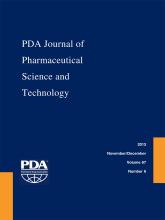Abstract
In relation to a growth in reported incidents of fungal contamination of pharmaceutical products, there has been a developing interest by U.S. and U.K. regulators concerning the risk of fungi. This paper describes a study undertaken to examine the suitability of different commercially available mycological agars for the environmental monitoring of pharmaceutical-grade cleanrooms. Five agars were evaluated in relation to the detection of both numbers and different species of fungi (yeasts and moulds). The objective was to determine if one mycological medium is more suitable than another. Data was collected using different sampling techniques (settle plates, active air samples, and contact plates) from different locations within representative cleanrooms. Samples were taken over a 3 month time period. The study results indicated that fungi are not distributed evenly across cleanrooms and that that the prevalence of fungi partly relates to the room design and operation. In relation to the different agar types, the study indicated that Sabouraud dextrose agar was the most effective at detecting the widest number of different types of isolates, and that Sabouraud dextrose agar and malt extract agar were the most efficient in terms of the numbers of recovered isolates. Other media, notably potato dextrose agar, was relatively less effective.
LAY ABSTRACT: There has been an increased regulatory concern about the presence of fungi in cleanrooms. Some environmental monitoring regimes are not especially orientated towards the examination of fungi, and it may be that special agars are required. Given the choice of different agars available, this paper outlines a case study where different fungal agars were evaluated. The study showed that Sabouraud dextrose agar was the optimal agar.
- © PDA, Inc. 2013
PDA members receive access to all articles published in the current year and previous volume year. Institutional subscribers received access to all content. Log in below to receive access to this article if you are either of these.
If you are neither or you are a PDA member trying to access an article outside of your membership license, then you must purchase access to this article (below). If you do not have a username or password for JPST, you will be required to create an account prior to purchasing.
Full issue PDFs are for PDA members only.
Note to pda.org users
The PDA and PDA bookstore websites (www.pda.org and www.pda.org/bookstore) are separate websites from the PDA JPST website. When you first join PDA, your initial UserID and Password are sent to HighWirePress to create your PDA JPST account. Subsequent UserrID and Password changes required at the PDA websites will not pass on to PDA JPST and vice versa. If you forget your PDA JPST UserID and/or Password, you can request help to retrieve UserID and reset Password below.






